Summary
Report of International
Conference on Combating Land Degradation in Agricultural Areas and the First
Annual Councilor Meeting of WASWAC (Landcon1010)
1.Conference
Background
The
International Conference on Combating Land Degradation in
Agricultural Areas and the First Annual Councilor Meeting of WASWAC
(LANDCON1010) was held in Xi’an, Shaanxi Province, China from
October 11th to 15th, 2010.
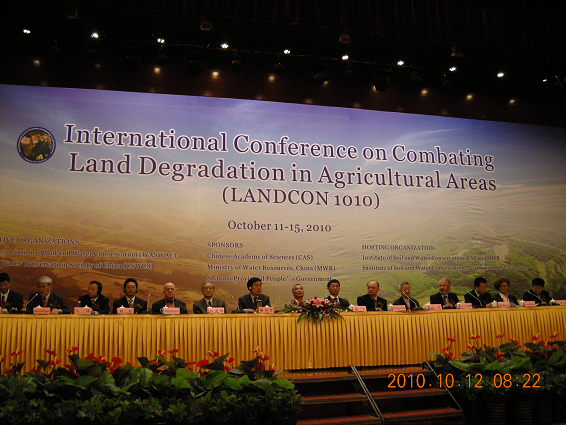
Land
is the foundation of human survives and development,
but the Land degradation is intensifying in many parts of the world because of
the unreasonable use and global climate change. According to the FAO’s
estimation in 2008, there are about 1.5 billion
people, or a quarter of the world’s population, depend directly on land that is
being degraded. Land degradation could induce the deterioration of the
ecological function and productivity of land directly through soil erosion,
desertification, salinization, loss of bio-diversity and so on. Furthermore,
the land degradation has already threatened and is threatening the
socio-economic and culture development at regional and global scales.
Fortunately,
the increasing attention has been paid in combating land degradation all over
world, such as the Soil and Water Conservation Engineering in the Upper and
Middle Reaches of Yellow River since 1980 and “Grain for
Green Project” of China, Landcare Project in Australia, the GEF
UNEP/FAO program on Land Degradation Assessment in Dryland Areas (LADA) and EU
FP6 Integrated Project on Desertification Mitigation and Remediation of Land
(DESIRE).
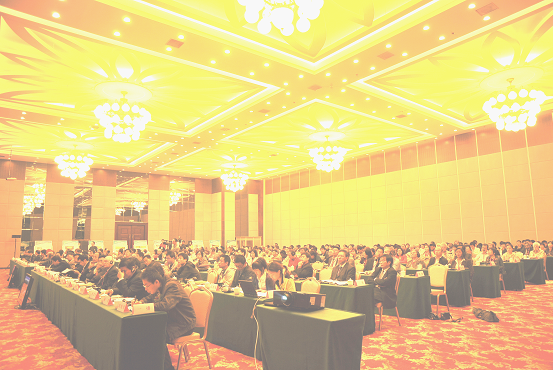
It
is necessary to have an opportunity to share achievements and experiences and
to discuss how to solve the big issue over the world. The World
Association of Soil and Water Conservation (WASWAC)
and Chinese Society of Soil and Water Conservation (CSSWC)initiated
the International
Conference on Combating Land Degradation in Agricultural Areas and the First
Annual Councilor Meeting of WASWAC (Landcon1010). During
this conference the main themes are following:
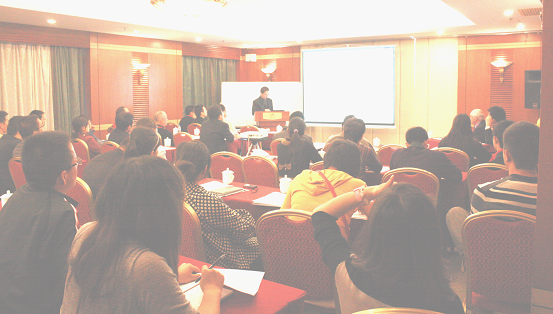
2.Conference
Organization
World
Association of Soil and Water Conservation (WASWAC)
Chinese
Society of Soil and Water Conservation (CSSWC)
Chinese Academy of Sciences
(CAS)
Ministry of Water Resources,
China (MWR)
Shaanxi Provincial People’s
Government
Europe Society for Soil and
Water Conservation (ESSC)
Shaanxi Bureau for Soil and
Water Conservation, China
Water Resources and
Hydropower Planning and Design General Institute, MWR, China
Monitoring Center of Soil
and Water Conservation, Ministry of Water Resources, China
Changjiang River Scientific
Research Institute (CRSRI)
Upper and Middle Yellow
River Bureau, YRCC
International Research and
Training Center on Erosion and Sedimentation (IRTCES)
Institute of
Eco-Environmental and Soil Sciences of Guangzhou, China
Northwest A&F University
Eijkelkamp Agrisearch
Equipment BV (EAE)
Institute of Soil and Water
Conservation, CAS & MWR
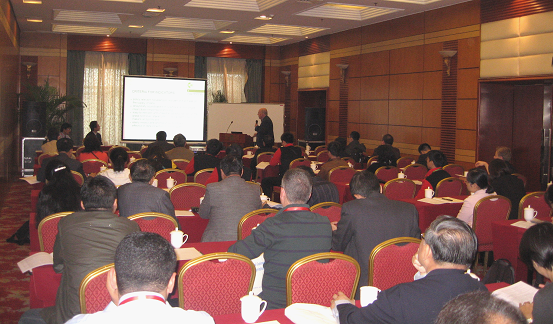
3.General
Situation and Main events
(1) Participants
There were 300 participants
from 36 countries covering Asia, Europe, America and Latin America, Africa, and
Australia to attend the conference. Many famous scientists in this field attended
and submitted presentations, such as Professors Sun Hong lie, Winfried E.H.
Blum, Jose L. Rubio, Chi-hua Huang, Miodrag Zlatic, Samran Sombatpanit, Shan
Lun, Coen C.J. Ritsema, Leo Stroosnijder, Doug Wimble, Hanspeter Liniger, and
Councilors of WASWAC.
(2) Academic
exchange
During the conference there
were 276 papers submitted, 120 oral presentation and 140 posters. All papers
were edited in Proceedings, which was issued by Springer THE SCIENTIFIC &
TECHNICAL DEVELOPMENT GROUP. All papers will be in ISTP and can be retrieved
from EI. All information can be read in WASWAC e-library.
(3) The
first WASWAC council meeting was held during the conference
Professor Miodrag Zlatic,WASWAC President chaired the meeting 30 people
attended,including 17
members of council and secretariat, 13 representatives of region or country.
The main
procedures are:
-
President
Miodrag Zlatic announced the result of election of new president
-
The
coming president professor LI Rui gave a short speech.
-
Discussion
and congratulation by participants
(4) WASWAC
Secretariat working meeting was held during conference
Chair: Mr Ning Duihu, Secretary General
Participants 17 attending the meeting
The main
issues to be discussed are:
(5) Some international cooperation projects were discussed or
proposed
-
DESIRE project involved 16 countries
-
China-Netherlands cooperation project of water resources
management Wei river
-
WOCAT in China
-
China-Serbia cooperation project.
-
China-Norway cooperation project
4.Main
outputs
(1) Proceedings
of 2010 International Conference on Combating Land Degradation in
Agricultural Areas
276 papers
were edited in the proceedings issued by Springer.
(2) WASWAC
e-library (LANDCON1010)
The 120 oral presentations,
140 posters, photos and related information will be edited in WASWAC e-library
(3) WASWAC
International conference 2013
According the decision of
council, every 3 years WASWAC will organize one International conference. Next
conference will be held in Thailand.
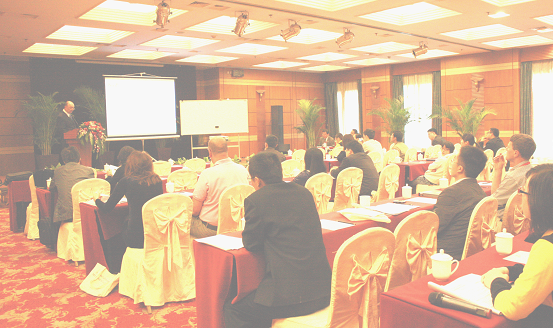
5.Key
Points of conclusions
(1) Land
Degradation is one of the most important issues over the world.
There is
more and more concern about climate change, the growing scarcity of fresh
water, the loss of wildlife, and pollution of the air and seas. But it is a
harshest reality that about a quarter of the world's agricultural land has
already been degraded, In the 1970s and 1980s alone, the world lost some 500
billion tons of topsoil. Every year about 12 million hectares - an area three
times the size of Switzerland - becomes useless to agriculture. Most of
presentations mentioned it is very urgent to pay more concern on our land. And we are going to need it more and more. As population and
demand are growing, the world will have to vastly increase food production. The figures from China are alarming. Two thirds of the marginal
farmland is in soil erosion areas and overall 34% of arable land has been
affected by soil erosion.
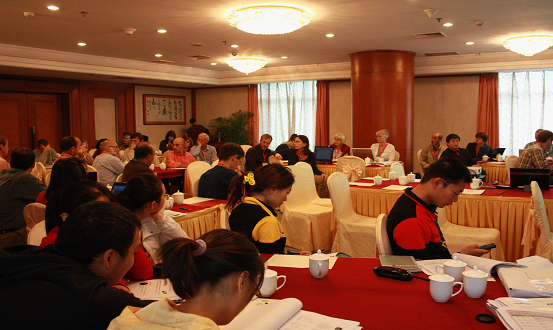
(2) Anthropogenic
forces become increasingly important for land degradation and conservation.
The land
deterioration is the serious environmental problem in the world. Many
presentations and papers analyzed both natural and human factors in land
degeneration. They emphasized particularly the activities of human beings, such
as over-cultivation, overgrazing, and felling of trees. Also, urban expanding
has embezzled more and more good farmland. On the other hand many examples show
that soil and water conservation can play an important role for combating land
degradation. Such as China's Loess Plateau, where the earth was first tilled many
thousands years ago, was long known as the most eroded place in the world, 1.6
billion tons of soil washed into the Yellow River every year. But now a big change
is taking place. Through such measures as terracing the barren slopes and
building small dams, the planting of new trees, especially implement of GRAIN
FOR GREEN project, the local yields and incomes have increased a lot. During1997-2006
the measured average annual runoff and sediment yield of meddle reaches of
Yellow river reduced 11.212 billion m3 and 1.18 billion T
respectively, compared with the year before 1970. Soil and water conservation
measures have played an important role.
(3) Assessment
of regional impacts of soil and water conservation on environment
Soil and
water loss and conservation both have brought many impacts on natural and
social environment at some content in the world. As matter as fact, the interaction
between land degradation and regional environment/social poverty is especially
serious. For example in China there are 76% of the impoverished counties lie in
areas of severe soil erosion and 90% of impoverished people live in areas
affected by soil erosion, As the saying goes, “The poorer you are the more you
must use the land, the more you use the land the poorer you become”. A major
factor in the cycle of land use and poverty is land degradation by erosion. On
the other aspect, soil and water conservation measures produce many impacts on
environment, positive and negative. The impacts include all influences on
water, soil, climate, biology and social conditions. There many papers and
presentations were related this issue during this conference. It is necessary
to use modern earth science and technology for the broad scale research of soil
and water loss, evolution futures and impacts on regional ecological
environment.
(4) Challengers
for Science and technology of soil and water conservation
Recently
there are many new challengers for science and technology of soil and water
conservation. Under the pressure from human activity and global climate change,
the biological-physical-chemical processes on the earth surface have more and
more new futures. As a result, the processes soil and water loss show some new
changes, Also the intension of soil and water conservation have been enlarged,
more comprehensive, more factors and more close to other related disciplines.
Such as due to the development of industry, urbanization, and construction,
soil and water loss is not only come from farming activity, but also mining,
road building and others. The measure of soil and water conservation is not
only including terracing, dam building, tree and grass planting, but also
physical-chemical and civil engineering. Especially the off-site impacts on
environment from soil erosion have brought many problems for regional
development. Along with the economical development the investment for soil and
water conservation has been increased. The scale of soil and water conservation
has enlarged from small watershed to region. So it is urgent to have more
research on new topics of soil and water conservation, such as soil process at
regional scale, soil erosion responses to global climate change, impacts of
soil erosion and control on environment, new measures for new type of soil.

